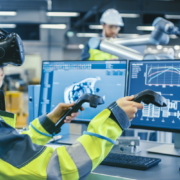El Niño: communities in the face of weather’s bad boy
South America must regularly face a climate event with far-ranging effects: El Niño, which leads to localized flooding. This type of catastrophe also results in changes in the behavior of local communities – a topic which has been little studied. Yet these changes provide a good example of individuals’ resilience to crises. By studying consumption habits in the regions affected by El Niño, Vincent Gauthier, a researcher at Télécom SudParis, seeks to understand how communities react to this event.
El Niño is a recurring climate event, which takes place every two to seven years on the equatorial Pacific coast of South America. It leads to localized heavy precipitation with serious consequences. “The 2017 El Niño phenomenon was especially violent and was characterized by two periods of heavy rainfall, resulting in human casualties and extensive destruction of physical structures,” says Vincent Gauthier, a researcher at Télécom SudParis who studies complex networks and is analyzing the impact of the 2017 episode on the behavior of the local community.
Peru was strongly impacted by the most recent El Niño phenomenon, especially in the north of the country and on its Pacific coast, which includes the Lima region. The episodes of rainfall gave rise to two periods of flooding: the first in February and the second in early April. Vincent Gauthier’s research seeks to understand how economic behavior changes before, during and after these periods.
To study these changes, the researcher uses data about consumption in the region. “Our approach is to analyze banking transaction data, with different granularity levels,” he explains. Studies were carried out in partnership with the Pacific University in Lima and led to the publication of a research article in the journal Plos One.
At the countrywide level, the results are conclusive: during each period of heavy rainfall there is a significant drop in the number and volume of transactions overall, therefore indicating that individuals consume less during the weather event. Transactions return to normal in the days following the rainfall, indicating that the overall impact is fairly limited in duration.
Resilience to El Niño
The study was then carried out in a specific way in the region of Lima, which includes the capital and surrounding rural areas. This made it possible to categorize areas according to dynamic changes in consumption. Unsurprisingly, the areas recording the most significant drops in transactions were the most affected by the rainfall. However, certain areas recorded rises in consumption before and during the episode, a behavior which may reflect a trend of purchasing as a precautionary measure.
To better understand such variations, Vincent Gauthier established a retail network model. This representation indicates not only consumers’ purchases, but also consumption paths. Such a model shows the various connections between stores, based on how busy they are, their ranking and the type of products sold. For example, a consumer who carries out a transaction at a pharmacy and then another at a supermarket strengthens the link between these two types of stores within the network. This makes it possible to study which links are the strongest in the event of a disturbance.
“During periods of heavy rainfall, the size of the network was strongly impacted,” says the researcher. “The connections were therefore reduced to stores that sell food, medical supplies and fuel. These connections represent the core of the network and if this core collapses, so does the whole system,” explains Vincent Gauthier. Modeling and studying resilience therefore allow us to understand the vulnerability and risks to this core network.
Using this approach, it can be seen that the first episode of rainfall had a stronger impact than the second one on the size of the core network, as well as on the time to it took to rebuild a wider network. Yet, the second period of rainfall was more violent from a weather perspective. This counterintuitive observation may be explained by better community preparedness for the second period of heavy rainfall and flooding. This difference in behavior highlighted by modeling is a marker of the resilience of the Peruvian people.
Understanding people through their purchases
To put these models in place, researchers used all the metadata associated with banking transactions. “Each transaction produces data accompanied by nomenclatures, which contain information about the type of store in which it was carried out, for example supermarkets, restaurants, pharmacies or service stations, “ says Vincent Gauthier. “This nomenclature also contains the date of purchase date and the anonymized identity of the person who made the purchase,” he continues.
This means that each individual’s purchasing path can be traced over time to provide an overview of his or her specific economic behavior during various periods. This analysis makes it possible to determine which stores are most often visited after one another by consumers, which is influenced both by the geographical proximity of the businesses to one another and similar interests among consumers.
“By analyzing this data, stores can be ranked according to the number and volume of transactions carried out there, then divergence measurements can be taken to identify changes in these rankings,” explains the researcher. The divergence measurements focus on differences in stores’ rankings at the time of the El Niño phenomenon compared to the original distribution. Such differences can also be seen during festive events, when there is a greater number of transactions in certain kinds of stores. “We therefore categorized stores based on the variation in their ranking during the El Nino phenomenon,” says Vincent Gauthier.
This approach allows researchers to create a profile of various stores over time so that they could see how their ranking varies at the time of events. For example, the ranking of restaurants fell sharply during the short periods corresponding to times of heavy rainfall, while the ranking of stores selling medical supplies increased for a relatively long period of time. Supermarkets were the type of store whose rankings were generally the most stable.
Better preparing for crises
“Future climate change will lead to an increase in extreme phenomena. Community resilience to these events will become an important issue to understand,” says Vincent Gauthier. The research carried out in relation to El Niño offers insights into community preparedness. It provides valuable knowledge for regions who are not used to dealing with extreme climate events, but who may have to face them in the years to come.
“That would make it possible to identify what services to develop and logistics to put in place in order to mitigate the effects of future crises, by organizing supply and inventory as well as keeping essential services open during crises. For example, we observed serious gasoline supply problems, although the demand for this product was high during the crisis and in its aftermath, and significant delays in consumption in geographic areas that were less exposed to the crisis,” says the researcher.
Beyond the climate issue, the wider issue of preparedness and resilience to crisis was studied. Understanding how the consumption network varies, what parts must be strengthened, or on the other hand, what parts are secondary, makes it possible to better focus efforts in an exceptional situation. The study of the current health crisis is a part of this work. “We’re studying the effects of the Covid-19 pandemic on the behavior of the Peruvian people, by analyzing consumption data as well as mobility data.” The analysis of mobility patterns could have a major impact on decisions to make in the event of a lockdown. “The methodology for the Covid-19 health crisis will be a bit different since the impact will be measured over a longer term unlike the crisis caused by El Niño where the underlying processes were essentially transitional,” concludes Vincent Gauthier.
Antonin Counillon













Leave a Reply
Want to join the discussion?Feel free to contribute!